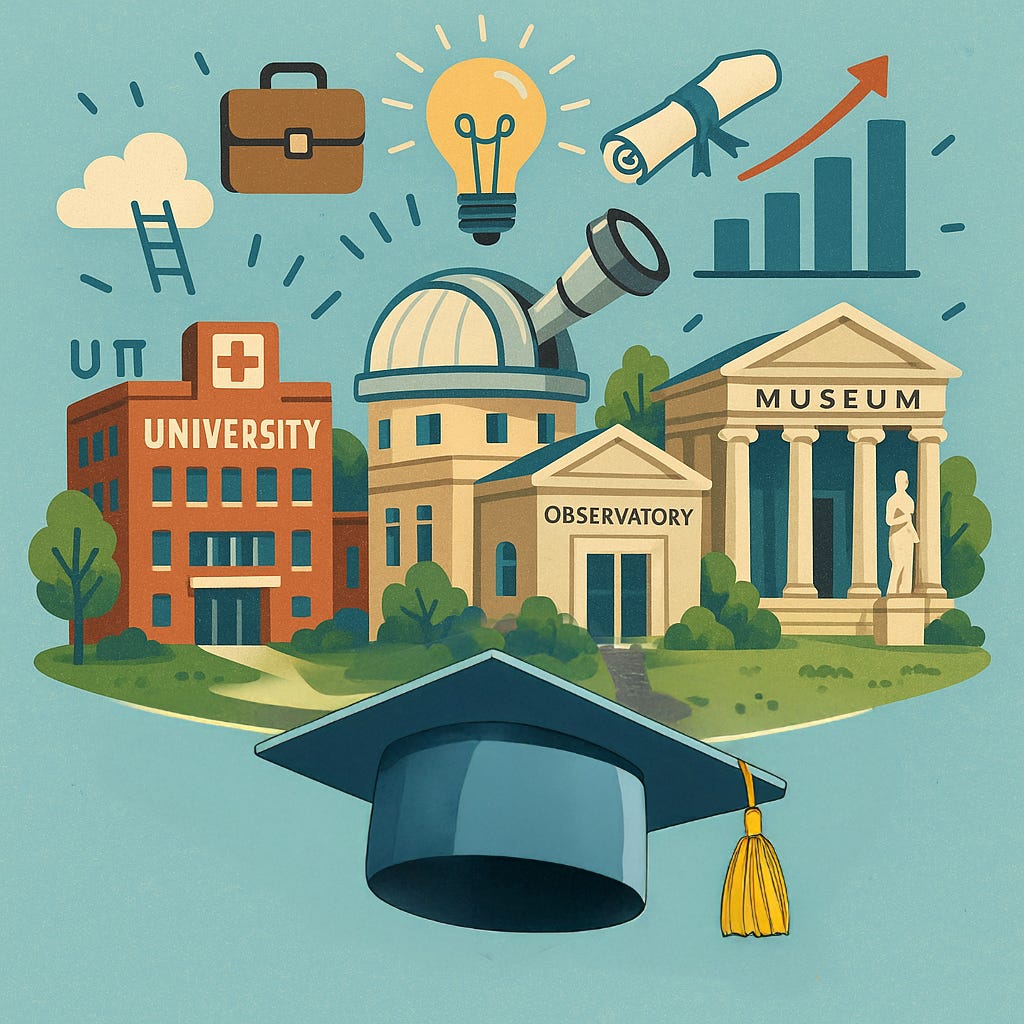Furthering Convergence Between STEM Trainees and the University Ecosystem
There's a world of possibilities if we look within
Graduate students and postdocs in STEM fields are often caught in a paradox. Despite their intensive training in research, many face significant financial and professional insecurity. In some parts of the US, the typical stipend barely covers living expenses, creating a constant state of financial anxiety. Kyle remembers joking with friends that he’d have to live under a bridge if his advisor couldn't fund him over the summer. While he can laugh about it now, this underlying stress is a reality for many trainees.
Author Nassim Nicholas Taleb, also a PhD, defines "fragility" as the state of breaking under stress. Unfortunately, this describes the situation for many graduate students and postdocs. The reality is that only a small minority of STEM PhDs will secure faculty positions at research universities, a challenge now compounded by severe cuts to government-backed research funds since January 2025. This creates a fragile dependency on government grants and teaching assistantships. Instead of perpetuating this fragility, universities should cultivate "anti-fragility"—the ability to not just withstand but thrive on volatility. The path toward going beyond resilience lies in looking inward and asking how a university's own resources can be recombined in novel ways to build something stronger than the sum of its parts.
Sharena’s experience is a testament to this challenge. She applied to graduate school knowing that she wanted to hone research skills to work primarily outside of academia. As a graduate student, she co-founded an automotive software startup. However, her graduate program sent her a formal letter incorrectly claiming that earning outside compensation violated NIH rules. After confirming with both her grant administrators at the university and the NIH that no such rule existed, she was left shaking her head at her program’s resistance. Out of fear, she deferred any compensation from startups she was part of until after graduation. For Sharena, the entrepreneurial experience was invaluable, directly strengthening her qualifications for the roles she pursued after earning a PhD.
Teaching assistantships should not be the only way besides grants for trainees to fund their education and research. Many trainees have neither an interest nor an aptitude for teaching university students.
Trainees could use more options.
Universities could, too.
To build more anti-fragility both trainees and universities should champion the development of versatile skills through hands-on, real-world experience embedded in the university ecosystem.
Here are a few potential opportunities:
Clinical and Technical Certifications: Biomedical science trainees who use techniques like EEG or MRI in their research could take electives to gain certifications and work part-time as medical technicians in their university's hospital. This would allow them to gain practical experience while funding their research. Sharena noticed that while people with two-year associate’s degrees in the medical trades can find stable jobs through their skills, people with PhDs often feel forced to do postdoctoral work because they do not see stability elsewhere. Ideally, these trainees would not be confined to research, but could also be an active part of the university’s healthcare workforce during terms they feel compelled to use their minds in patient care. Further, these experiences may lead to more innovation in the medical ecosystem. Skilled researchers would learn to meet clinical needs in practice and communicate with medical personnel. Similarly, astrophysics trainees at universities near observatories could be trained as telescope operators. Kyle is still surprised that many of his peers in astrophysics never learned how to work with telescopes. By repurposing STEM research labs and museums into community learning hubs, universities can empower their trainees to lead hands-on workshops that train diverse groups—from local high school students to older adults seeking new skills—on sophisticated equipment such as microscopes and lasers.
Cross-Disciplinary Training: STEM trainees can gain invaluable experience by cross-training in their university’s tech transfer office or entrepreneurship center. This can help them explore careers in innovation commercialization and intellectual property law through hands-on problem solving. Because many STEM trainees have a bachelor’s, master’s, or doctoral degree in an eligible science or engineering discipline, they are eligible to take the patent bar. Thus, if they find enjoyment from working with intellectual property, they can even become registered as patent agents.
Industry-Academic R&D Collaborations: University labs can seek partnerships with corporations to meet research and development needs, with funding from corporations. This can help to test ideas before allocating more attention of internal company personnel to these projects. This can also create a pipeline for the trainees to explore collaborations with corporate partners, and potentially transition to being employed by these companies using the skills they developed.
Internships and Fellowships: Programs like the Simons Foundation Predoctoral program, the Momental Foundation’s Mistletoe Research Fellowship, and the AAAS Science & Technology Policy Fellowships offer paid, non-academic placements that allow trainees to apply their expertise in new contexts.
Open-Source Development: Global programs like Google Summer of Code (GSoC) and Outreachy offer stipends for trainees to contribute to open-source software projects, building tangible skills and professional networks.
Integration with the University’s Centers for Outreach or University Extensions: Trainees can leverage their expertise through outreach and mentoring including the design of outreach programs. Many universities offer high school programs, especially during the summer months. This is one source of income both for the university and for the trainees who work with them. Working with the university extension may allow trainees to develop curricula for helping current professionals level up their skills.
By encouraging trainees and universities to pursue these avenues, the university ecosystem can evolve from a narrow training pipeline into an anti-fragile launchpad for a dynamic and unpredictable world. Creating greater convergence between STEM trainees and the university ecosystem isn't just beneficial—it's essential for creating adaptable professionals who can turn uncertainty into an opportunity for growth, ultimately strengthening both the individual and the academic institution they are part of.




